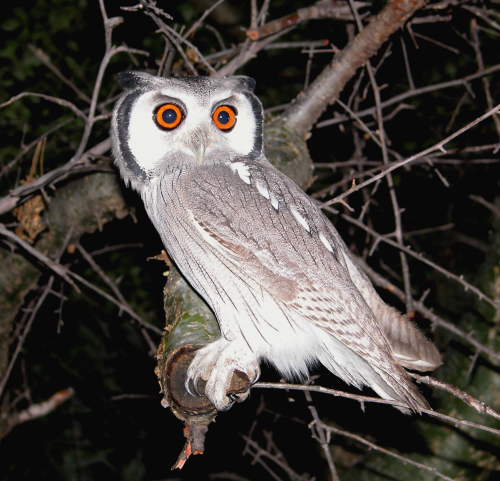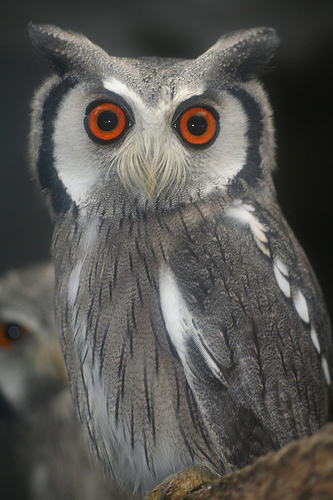
Ptilopsis granti
SUBFAMILY
Striginae, Tribe Otini
TAXONOMY
Pisorhina leucotis granti Kollibay, 1910, Namibia. Until recently
this bird was placed in the genus Otus. It is very closely related,
but was shown to be different by molecular biology; it has
larger eyes than Otus species. Monotypic.
OTHER COMMON NAMES
English: White-faced scops-owl, white-faced owl; French: Petit-
duc de Grant; German: Sьdbьscheleule; Spanish: Autillo
Cariblanco Sureсo.
PHYSICAL CHARACTERISTICS
8.7–9.4 in (22–24 cm). Female, 4.4–9.7 oz (125–275 g). Male,
6.5–7.8 oz (185–220 g). Head features long ear tufts, a whitish
facial disc with a black rim, and orange-red to red eyes. Upperparts
are darker gray with black markings. Underparts are
lighter gray with thin dark streaks and lines.
DISTRIBUTION
Africa from equator on down.
HABITAT
Savanna, open woodlands, and forest edges.
BEHAVIOR
Sedentary, although it can be nomadic in drier parts of its
range.
FEEDING ECOLOGY AND DIET
Large insects, small mammals, birds, and reptiles. Will hunt
from perches including telegraph poles and even street lamps.
REPRODUCTIVE BIOLOGY
Uses old nests of other birds, such as pigeons, or nests in a
cavity in a tree or branch. Lays two to three eggs. Incubation
is 30–32 days. Young leave nest at four weeks.
CONSERVATION STATUS
Not globally threatened. Reasonably common in most of its
range as of 2002.
SIGNIFICANCE TO HUMANS
None known.
Other popular Animals
Photo Gallery of - Southern white-faced owl




 Animalia Life
Animalia Life